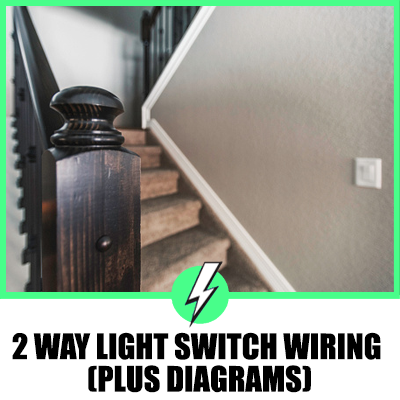2 Way Light Switch Wiring (Plus Diagrams)
Do you find the thought of wiring switches bewildering? How can you wire a two-way switch, so your lights come on upstairs?
DIY enthusiasts often find wiring switches a complete mystery when it is not difficult. When you understand how a two-way switch works, you can easily progress to a three-way switch. Two-wire a switch, so your lights come on in a different location, switching live for neutral in the Common terminal.

Contents
How do you wire a two-way switch?
Ok, you always bring your live wire (brown), also known as the common, into the top of the switch. Make sure the circuit is switched off before starting to terminate the connections.
Bring the neutral from the ceiling rose into the base of the switch and terminate the connection. This is a basic on-off light switch.
Now to wire a two-way switch, you will need to bring your common into one switch and terminate.
Take your neutral (blue) wire to the common on your next switch and terminate. You will have two terminals on the base of each switch connecting terminals 1 to 1 and 2 to 2.
The switch is now complete, as shown in the schematic.
This switching combination is used in older homes and works well, but 3-way switches are preferred for new builds.
The downside to wiring this way
Taking this method of wiring is referred to as the cable saving method. Cable saving is a hangover from the 2 world wars, and electrics have come a long way. It only uses two wires for control.
There is a possibility that the neutral terminations could come from other lighting circuits using this configuration. The base of the stairs could be different from the top of the stairs.
This is dangerous, so there is a simple way of wiring: a 2-way switch 3 wire system.
Two-way lighting switch 3 wire system
From this diagram, you can see that the wiring from the rose is much simpler and provides an effective way of switching.
How does a 2-way lighting circuit work?
The term 2 way in switching means you have two switches in two different locations to control one bulb.
This configuration is mostly found in stairwells, so you can turn off the landing light and vice versa when you go to bed.
If you don’t feel confident about wiring switches, you should call an electrician as switches can be wired incorrectly and still work, but they will generate heat and may cause a fire.
What is the common wire on a 2-way switch?
When you remove the faceplate from the switch, you will see that COM has the letter C at the top of the switch.
The common is for the live feed, the brown wire.
You will see L1 at the bottom of the switch; this is for the output from the light switch.
Can you wire a plug socket from a light switch in the UK?
The lightning cable is insufficient to carry a 13 amp per outlet socket. The lighting cable usually is 1.5 mm, and the socket cable is 2.5 mm, so it can carry more amps for your appliance. Using the lighting circuit could use the cable to its maximum capacity.
Does it matter which wire goes where on a light switch?
Yes and no, if you wire both switches the same, it does not matter where the wires go, provided it’s the same as the other switch.
It may mean your switch will work upside down which some folks would find irritating. To correct this, it takes a few minutes to wire correctly.
Do light switches have a neutral?
It depends. If it’s the light-first-wiring, then no.
For a traditional switch to turn a light on and off, it needs to make and break the circuit. Traditionally in the UK, this is wired such that the live (brown) and neutral (blue) wires (old houses may have red and black cables, respectively).
The primary power source (the incoming power) goes to the light fitting first, then the live is sent to the switch, and finally, the switched live (the live that is made and broken) is sent back to the light.
This is referred to as “light-first wiring” which means you do not have a neutral at the switch. The live from the light to the switch uses the brown wire, then the switched live uses the blue wire and is normally marked with some brown tape to indicate it is a switched live and not a neutral.
How do I wire a smart switch without a neutral wire?
You can’t. In the UK, the cable to your lighting will be twin and earth T&E so that a neutral blue wire will be present.
If you want to use a smart switch, you will need to have a neutral wire installed or a new lighting cable, which sounds like the best option.
It is worth letting a qualified electrician figure this one out. They may be able to thread an additional neutral cable through the conduit to the switch.
Do smart light switches need a ground wire?
No, the switch needs constant power. A smart switch lets you control your lights remotely using an app on your phone from anywhere with an internet connection.
The system uses its electronics Vss or GND for earthing, so never attach earth to a smart switch.
How to connect a 2 way light switch?
To connect a 2-way light switch, follow these steps while ensuring all safety precautions are taken:
- Safety First: Turn off the power and verify it’s off.
- Wiring Overview: Familiarize yourself with the 2-way switch terminals: common (C), L1, and L2.
- First Switch Connection: Connect the live wire to the common terminal, and use a 3-core cable to connect L1 and L2 to the second switch.
- Run Cable: Extend the 3-core cable from the first to the second switch.
- Second Switch Connection: Match the L1 and L2 connections from the first switch and connect the common terminal to the light fixture’s live wire.
- Light Fixture: Connect the light fixture to the second switch’s common terminal and ensure the neutral wire is also connected.
- Grounding: Secure all ground wires.
- Test: After double-checking connections, turn the power back on and test the switches.
Always prioritize safety, and consider hiring a professional electrician if you’re unsure about the process.
What is the difference between a neutral wire and a ground wire?
Both are important conductors and should never be touched. Your blue neutral wire completes the circuit and allows the electricity to flow back to the consumer unit.
The ground wire, aka earth, is your defence mechanism in a circuit. If a fault develops, the green and brown earth carries electricity to the ground.
Can the neutral wire shock you?
Yes, the neutral takes the electricity back to the consumer unit and can carry as much voltage and maps as the live wire. If you touch it, the electricity will choose to run to the ground through your body which could be fatal.





